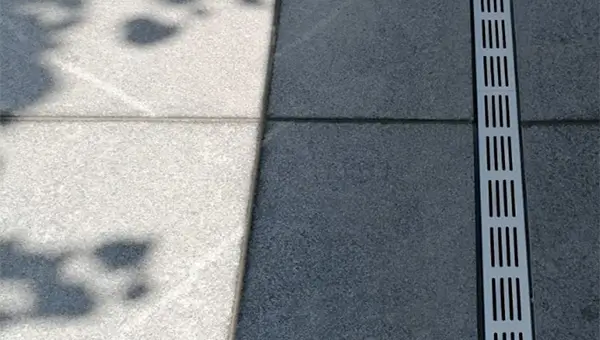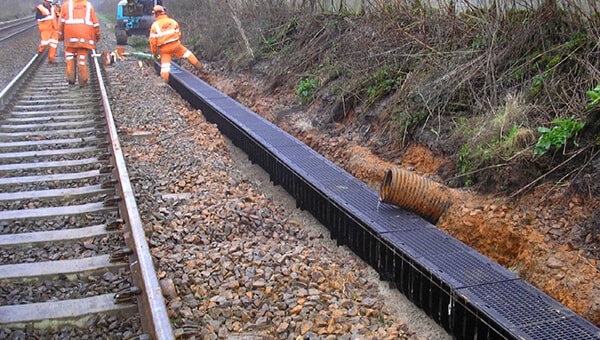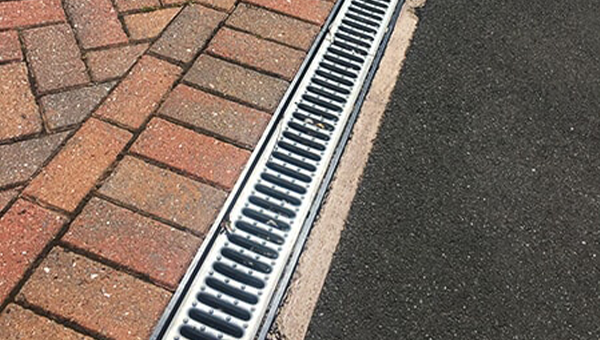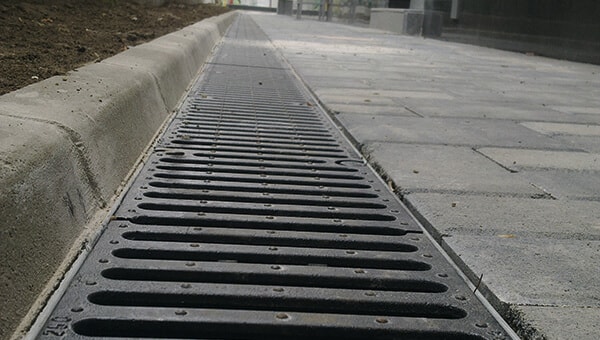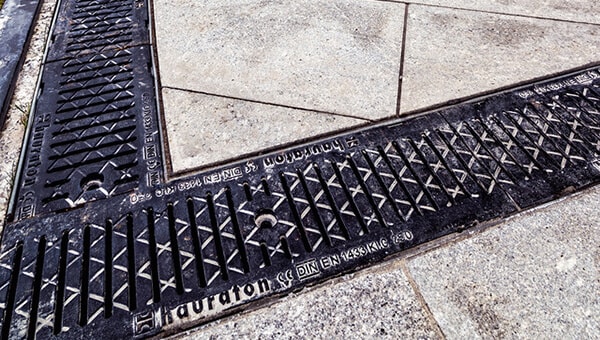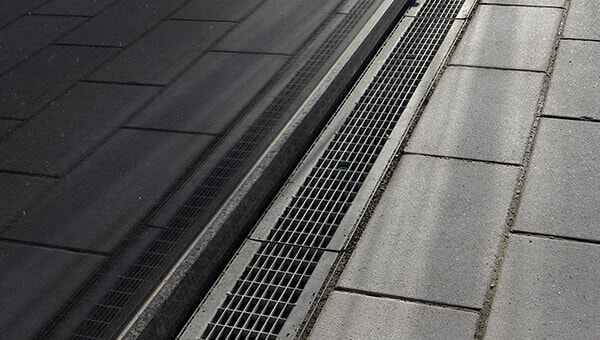
Linear channel drainage plays an important role in surface water management for residential, commercial, and industrial landscapes. With a straightforward design, these drainage systems aptly employ linear channels to collect and redirect rainwater and surface water runoff away from structures to mitigate flooding risks and enhance overall safety.
Channel drains, with their practicality, efficiency, and affordability, emerge as the go-to solution for handling surface water runoff from outdoor areas like driveways and patios. However, the market teems with a diverse array of linear channel drainage options, a spectrum that might leave you pondering the best fit. The intent of this article is to help you better understand the various kinds of linear channel drains available in the UK so that you may make a more informed decision about which type to buy for your project.
The advice in this article is given with the assumption that you already know what the most suitable channel drain loading class is for your application. If not, we highly recommend redirecting your attention first to our companion article, “Choosing the right loading class for your channel drain application”. Only once you understand the loading requirements of your application should you move on to deciding what type of channel drain materials will be best suited for it.
To do this, you need to ask the following question:
- What is the most suitable material type – what does the channel drain need to be made from to accommodate the loading requirements?
- What is the most suitable grating type - what hole patterns are best for the application?
To help you answer these questions, we’ll now take a closer look at each one individually while also explaining how the answers can influence each other.
Please Note:The information provided in this article is intended to give a general overview of channel drainage options available in the market. Any features and benefits or pros and cons listed are indicative of a “typical” product and are offered for guidance only as they can differ between manufacturers. Please always check a product’s specifications and description before deciding if it is suitable for your project.
Channel Drain Material Types
From the enduring strength of Concrete Channel Drains to the corrosion-resistant allure of Steel Channel Drains, the lightweight ease of Plastic Channel Drains, and the specialised versatility of Fibreglass Channel Drains, each material brings its own set of characteristics to the table. To help you make this decision, let’s take a closer look at the unique attributes of these material types, shedding light on the benefits and limitations they offer within the realm of linear channel drainage. By understanding the intricacies of these materials, you'll be better equipped to make informed decisions when selecting the optimal linear channel drain solution for your project.
Plastic Channel Drains
Plastic channel drains have garnered popularity in the UK market owing to their lightweight nature, easy installation, and affordability. These channels find their niche in residential and DIY applications, including garden paths, slopes, and terraces. The load capacity of plastic channel drains typically spans from A15 to C250, reflecting their ability to withstand loads up to 25 tonnes. The A15 load class caters to pedestrian areas, while the C250 load class accommodates light vehicle traffic, such as cars and vans.
Certain types of plastic do offer higher load-bearing capabilities, such as the RECYFIX NC 100 DI E600 Channel Drain from Hauraton, but they aren’t usually recommended for high-trafficked areas such as motorways, etc.
Pros:
- Lightweight and Easy to Handle – Plastic channel drains' lightweight construction makes them simple to manage during installation.
- Cost-Effective - These channels offer an economical solution for various drainage needs.
- Chemical and Corrosion Resistance - Plastic channels resist the effects of chemicals and corrosion, making them suitable for spaces like swimming pool areas and gardens.
- Quick and Easy Installation - Plastic channel drains often come with snap-together components that facilitate straightforward installation and maintenance.
- Suitable for Light to Medium-Duty Applications - Ideal for applications like patios and driveways, plastic channels handle light to medium loads effectively.
Cons:
- Lower Load-Bearing Capacity – Plastic channels typically have a lower load-bearing capacity compared to some alternative materials.
- UV Degradation Vulnerability - Over time, plastic channels can be susceptible to UV degradation, potentially affecting their performance.
- Limited Lifespan - The lifespan of plastic channels is relatively shorter when compared to more durable material options.
Fibreglass Channel Drains
Fibreglass channel drains, also known as glass-reinforced plastic (GRP), composite plastic, or FRP channel drains, emerge as a versatile solution for both residential and commercial purposes. Characterised by their lightweight build, corrosion resistance, and capacity to withstand loads of up to C250, these drainage systems excel in settings like patios, pool areas, and driveways. Their easy installation and low maintenance needs further enhance their appeal.
Pros:
- Excellent Corrosion Resistance – Fiberglass channel drains exhibit remarkable resistance to corrosion, extending their lifespan in diverse environments.
- Lightweight and Easy to Handle - The lightweight nature of these drains simplifies the installation process.
- Chemical Resistance - Fiberglass channels stand resilient against a variety of chemicals, making them suitable for demanding environments.
- Efficient Water Flow - Their smooth interior surface facilitates efficient water flow, aiding in effective drainage.
- Suitable for Specialized ApplicationsThese channels find their forte in specialised applications due to their chemical resistance and durability.
Cons:
- Higher Initial Cost – The initial investment in fibreglass channel drains tends to be higher compared to alternative materials.
- Limited Design Options - Design choices might be relatively more restricted compared to other material options.
- Impact Damage Vulnerability - Fiberglass channels can be vulnerable to impact damage if not handled with care during installation and maintenance.
Galvanised Steel Channel Drains
Galvanised steel channel drains have gained popularity for their high strength and corrosion resistance and are commonly used in light commercial and residential applications. Particularly fitting for domestic driveways, patios, and gardens, these channels exhibit a load capacity ranging from A15 to C250, enabling them to withstand loads up to 25 tonnes. The A15 load class suits pedestrian areas, while the C250 load class proves ideal for car parks and private roads.
Pros:
- High Strength and Load-Bearing Capacity – Galvanised steel channels boast impressive strength, capable of handling substantial loads of up to C250.
- Excellent Corrosion Resistance - The zinc coating on the steel protects against rust, ensuring longevity even in corrosive environments.
- Long Lifespan - Thanks to their corrosion-resistant nature, galvanised steel channels offer a prolonged lifespan.
- Heavy Traffic Tolerance - These channels can effectively handle the demands of heavy traffic loads.
Cons:
- Heavier and Challenging to Handle – Galvanised steel channels are heavier, making installation more labour-intensive.
- Higher Initial Cost - While they offer durability, their initial cost can be higher compared to other material options.
- Vulnerable to Scratches or Damage - Scratches can expose the underlying metal to potential corrosion, necessitating touch-up coating.
Stainless Steel Channel Drains
Stainless steel channel drains have gained significant popularity in the UK market due to their impressive corrosion resistance, hygienic attributes, and aesthetic allure. They find common use in both residential and commercial settings, such as swimming pools, outdoor kitchens, and retail areas. The load capacity spectrum of stainless-steel channel drains typically spans from A15 to D400, signifying their capacity to bear loads of up to 40 tonnes. The A15 load class suits pedestrian zones, while the D400 load class caters to car parks and public spaces.
Pros:
- Excellent Corrosion Resistance – Stainless steel channels exhibit remarkable resistance to corrosion, ensuring prolonged functionality in diverse environments.
- Sleek and Modern Appearance - The sleek design of stainless-steel channels contributes to a modern and sophisticated visual appeal.
- Architectural and High-End Applications - These channels are a favoured choice for architectural and upscale projects due to their elegant appearance.
- Long Lifespan - Their corrosion-resistant nature equates to a longer lifespan, reducing the need for frequent replacements.
- Variety of Grate Designs - Stainless steel channels come with a range of grate designs, accommodating various aesthetic preferences.
Cons:
- Higher Cost – The initial cost of stainless-steel channel drains tends to be higher compared to alternative materials.
- Relatively Higher Thermal Conductivity - Stainless steel's thermal conductivity can be higher than some other materials, affecting temperature regulation.
- Maintenance Requirements - Regular maintenance is needed to preserve the aesthetic appeal of stainless steel, as it can be susceptible to scratches and stains.
Concrete Channel Drains
Concrete, or Polymer Concrete, channel drains have long been favoured in the UK market due to their exceptional strength, durability, and resistance to chemicals. These channels find their ideal application in high-traffic zones like car parks, industrial sites, and motorways, but can be used for just about any project. Their load capacity varies from A15 to F900, showcasing their ability to endure substantial loads, ranging from pedestrian areas to heavy-duty environments such as airports and cargo terminals.
Pros:
- Durable and Long-lasting – Polymer concrete channels offer remarkable longevity, withstanding wear and tear over time.
- Chemical and UV Resistance - These channels are resilient against chemicals and UV degradation, ensuring a prolonged lifespan even in challenging environments.
- Lightweight and Manageable - Despite their robust nature, polymer concrete channels remain lightweight, facilitating easy handling during installation.
- Versatile Sizing and Configurations - Available in an extensive range of sizes and configurations, these channels cater to diverse drainage needs.
- Effective Debris Prevention - Built-in grates effectively prevent debris from entering the drainage system, maintaining its functionality.
Cons:
- Higher Cost – Polymer concrete channel drains can be relatively more expensive upfront compared to alternative options.
- Design Limitations - While they come in various sizes, design choices might be more restricted compared to channels made from other materials.
It's important to note that the pros and cons may vary based on specific product variations and manufacturers. Considering factors such as application requirements, budget, durability, aesthetics, and maintenance needs will help in selecting the most suitable channel drain material for a particular project.
The following table offers a quick reference guide for matching up the different channel drain materials with the loading classes they are suitable for:
| Channel Drain Material | A15 | B125 | C250 | D400 | E600 | F900 |
|---|---|---|---|---|---|---|
| Plastic Channel Drains | - | - | - | |||
| Fiberglass Channel Drains | - | - | - | |||
| Galvanised Steel Channel Drains | - | - | - | |||
| Stainless Steel Channel Drains | - | - | ||||
| Concrete Channel Drains |
Channel Drain Grating Materials
Channel drain gratings, sometimes known as drain covers, drain grids, or drain grates, are an essential part of the channel drain system. They simultaneously allow water to flow into the channel, prevent debris from following it, and stop the drain from being a trip hazard. Just like the channels, the gratings can be made from a variety of materials, from plastic and steel to cast and ductile iron, to suit the various loading requirements. The pros and cons of each material and the loading classes they are suitable for are largely similar to those for the channels, the only real difference being that concrete is replaced with Ductile Iron and Cast Iron as the material of choice for loading classes up to E600 and F900 respectively.
Here's another table offering a quick reference guide for matching up the different channel drain grating materials with the loading classes they are suitable for:
| Grating Material | A15 | B125 | C250 | D400 | E600 | F900 |
|---|---|---|---|---|---|---|
| Plastic Channel Gratings | - | - | - | |||
| Galvanised Steel Channel Gratings | - | - | - | |||
| Stainless Steel Channel Gratings | - | - | ||||
| Ductile Iron Channel Gratings | - | |||||
| Cast Iron Channel Gratings |
The material type is only one aspect of the right channel drain grating, though, as they also come in a number of different designs. Once you’ve chosen the material that best suits your loading requirements, you then need to consider other things like the required flow rate the grating needs to accommodate or the type of debris it needs to prevent from getting into the drainage system. Let’s take a look at the most common grating types in more depth to help you find the right one for your project.
Channel Drain Grating Types
Once you’ve evaluated what the most suitable material for your channel drain grating is, the next choice you have to make is regarding the grating pattern. All channel drain gratings are designed with some configuration of holes or slots that allow water to drain through while preventing various degrees of debris from following. However, not all channel drain applications have the same requirements. Some need to deal with higher volumes of water than others, some have to deal with potential blockages being caused by finer debris, and others require a primary focus on not becoming a trip hazard to the public. To accommodate the various combinations of requirements found in most typical channel applications, channel drain gratings are available in a number of different styles to suit. Let’s take a look at the most common ones to see which might be best for your application.
Terminology Note:Naming conventions for channel drain gratings are anything but standard, unfortunately. What one manufacturer calls standard, others call slotted, and what some call slotted, others call heelsafe. It can get maddeningly confusing even for people in the know. In the following section, we’ve tried to make some sense of this as best we can, but the images provided should help you find the right information for each style, even if you know the design by a different name.
Channel Drain Standard Gratings
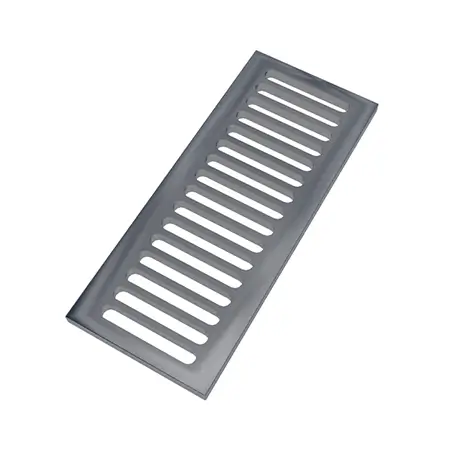
Standard Gratings are the most common type of channel drain grating. They have parallel bars with large gaps between them, which allows for a high flow rate of water. Standard gratings are a good choice for areas with heavy traffic or where there is a lot of debris that needs to be filtered out of the water.
However, their design isn’t well suited to capturing smaller debris compared to other grating types, meaning they typically require more maintenance to keep them working in optimal condition. Their resistance to bending and twisting is moderate, catering well to common pedestrian and light vehicle traffic scenarios, but they lack specialised features for heel safety, which can impact their suitability in certain pedestrian areas. Standard gratings often cover a wide spectrum of loading classes and are available in most material types.
Pros:
- Widely available and commonly used.
- Effective at capturing larger debris.
- Suitable for a wide range of applications, from residential to commercial settings.
- Promote efficient water flow while preventing clogging.
Cons:
- May not be as visually appealing as other grating types.
- Can become slippery when wet.
- Less effective at preventing smaller debris from entering the drainage system.
- Require regular maintenance to prevent clogs.
Channel Drain Slotted Gratings
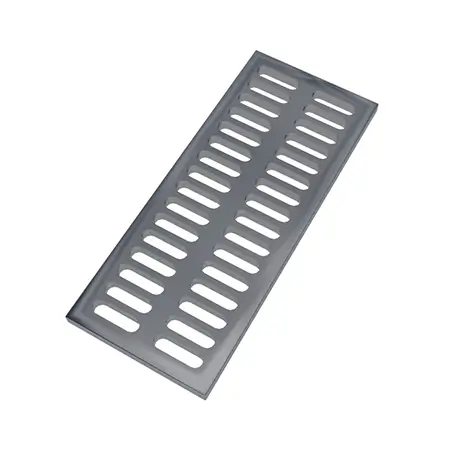
Slotted gratings have a double row of parallel bars that have smaller gaps between them than standard gratings. These smaller openings promote better debris capture, but they also reduce the flow rate of water. This makes them less likely to allow smaller debris to enter the drainage system but at the cost of being less capable of managing heavy surface water runoff.
They offer moderate resistance to bending and twisting, making them suitable for light to medium-duty applications, but often prioritise the sleek appearance over specialised heel safety. Slotted gratings are a good choice for areas where it is important to prevent small objects from entering the drainage system but are less so for areas where the water runoff rate may be high. They align well with a variety of loading classes and are available in most material types, allowing them to be installed in applications ranging from pedestrian zones to light vehicle traffic areas.
Pros:
- Efficiently drain water while providing an increased surface area for debris capture.
- Better at catching smaller types of debris than standard gratings.
Cons:
- May have narrower openings that are prone to clogging with fine debris.
- Require regular maintenance to prevent clogs.
Channel Drain Mesh Gratings
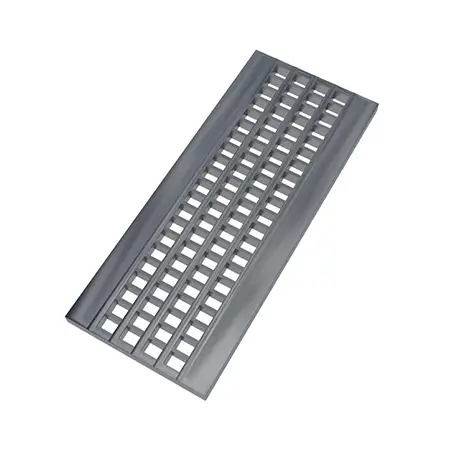
Mesh Gratings typically use a grid of small squares to cover the opening of the channel drain. This makes them very effective at filtering out debris of all sizes, but it can also reduce the flow rate of water even more than slotted gratings. Mesh gratings are a good choice for areas where there is a lot of fine debris that needs to be filtered out of the water, such as around swimming pools or in parking lots.
They have a good resistance to bending and twisting, making them suitable for light and medium-duty applications. While they might not offer specialised heel safety features, the small openings in the mesh are much less of a potential hazard than slotted or standard gratings. They tend to be manufactured from either plastic or steel materials and aimed at loading classes that cater to pedestrian zones and medium-duty vehicular traffic.
Pros:
- Prevent both small and large debris from entering the drainage system.
- Ideal for areas with heavy foliage and debris accumulation.
- Suitable for parks, gardens, and locations with substantial vegetation.
Cons:
- May require more frequent cleaning due to the fine mesh structure.
- Can restrict water flow if not adequately maintained.
- May not be as visually appealing as other grating types.
Channel Drain Longitudinal Gratings
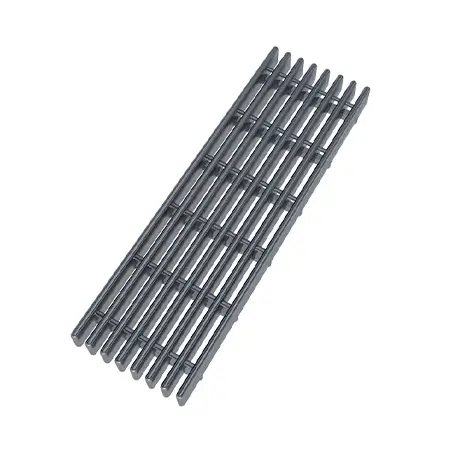
Longitudinal Gratings have bars that are arranged in a longitudinal (lengthwise) pattern, which grants them a robust load-bearing capacity and excellent water flow capabilities. Their elongated openings make them more resistant to bending and twisting than standard gratings, which makes them a good choice for areas with heavy traffic.
Longitudinal gratings are often geared towards scenarios where specialised heel safety features are not a primary concern. They typically align with the higher loading class materials to support their use in vehicular traffic and heavy industrial areas.
Pros:
- Designed to handle heavy loads and offer excellent water flow capacity.
- Ideal for areas with high traffic and heavy vehicles.
- Can be visually appealing with their elongated openings.
- Prevent clogging and promote efficient drainage.
Cons:
- May not be as effective at capturing small debris compared to mesh gratings.
- Require careful installation to ensure alignment and stability.
- May have higher initial cost due to their durability and load-bearing capacity.
Channel Drain Heelsafe Gratings
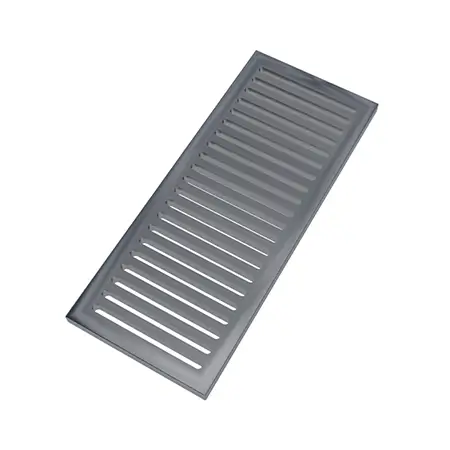
Heelsafe gratings are engineered to focus on pedestrian safety with narrow openings that are spaced close together. This makes it difficult for high heels and small objects to get caught or trapped in the grating. This feature enhances safety in areas with heavy foot traffic, such as shopping centres and walkways, while still retaining a decent water flow capacity.
Heelsafe gratings are not primarily designed for heavy load applications as their resistance to bending and twisting is tailored for light-duty scenarios. As such, they tend to conform to loading classes suitable for pedestrian applications.
Pros:
- Specifically designed to prevent high heels and small objects from getting stuck.
- Enhance safety in areas with foot traffic, such as shopping centres and pedestrian zones.
- Efficiently drain water while ensuring pedestrian comfort and safety.
- Reduce the risk of accidents and injuries caused by trapped heels or objects.
Cons:
- May have a higher initial cost compared to standard gratings.
- Require more precise manufacturing due to their specialised design.
- May have narrower openings that could be prone to clogging with fine debris.
- Limited to applications where pedestrian safety is a primary concern.
Technically speaking, any channel drain grating with holes that are too small for a high-heeled shoe to get stuck in can be classed as “heelsafe”. However, if this is a crucial feature required for your application, it’s best to look for gratings that specifically state it as part of their design.
Here is a table that summarises the key features of each type of channel drain grating:
| Type of Grating | Flow Rate | Debris Retention | Resistance to Bending and Twisting | Heel Safety |
|---|---|---|---|---|
| Standard Grating | High | Medium | Medium | Low |
| Slotted Grating | Medium | High | Medium | Medium |
| Mesh Grating | Low | Very High | High | High |
| Longitudinal Grating | Medium | High | High | Medium |
| Heelsafe Grating | Low | High | Medium | Very High |
If you want something more decorative, there are fancier options out there and even companies that will make bespoke channel drain gratings for you, but expect to pay a premium price for them. If you do decide to look into something like this, make sure you know exactly what you need (i.e. loading class, flow rate, etc.) so that you can ensure the bespoke grating will be suitable for your application.
Having a clear understanding of your application needs is vital to being able to select the right channel drain material or grating material and design. The key thing to remember is that grating and channel must both be suitable for the recommended load class of your application. The system as a whole is only as strong as its weakest component. If you choose a concrete drainage channel that is capable of sustaining loads of up to 90 tonnes (F900) but give it a plastic grating that can only withstand up to 12.5 tonnes (B125), your channel drain system will only be suitable for B125 loading applications.
Match your material choices to the loading class of your application and then narrow down your choice of grating by which pattern design will best fit the needs of the intended environment. Do this, and you should have no problem finding the perfect channel drainage system.
And that’s it for our guide to channel drain materials and grating options. We hope it has been informative and helpful, but do check out our other articles, “Choosing the right loading class for your channel drain application” and “Choosing the right channel drain for your project” for further information. If you are in the market for high-quality channel drain systems, we stock a great range of channel drainage products for all loading classes over in our Channel Drain section that we'd recommend taking a look at.
If you have any other questions about channel drain materials and grating options or need any further advice about channel drainage in general, contact JDP today. Our team of experts are always on hand to help with all of your civils and drainage needs.


